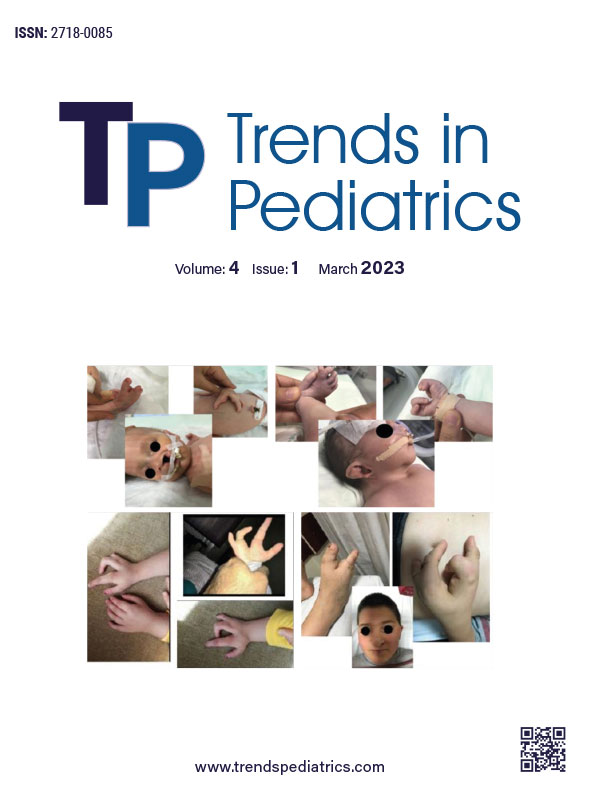Abstract
Objective: Zonulin is a biomarker of increased intestinal permeability. Malnutrition is strongly associated with prolonged length of stay, increased infection, and mortality. This study aimed to determine how the serum zonulin level is affected in patients in PICU, and evaluate the relationship between pre-albumin and Vitamin D.
Method: 35 critically ill pediatric patients were included in the study. The control group was formed of 25 healthy children. The albumin, pre-albumin, Vitamin D, and zonulin levels were examined in patients with findings of infection that regressed during ICU follow-up. The differences between prealbumin levels, Vitamin D, and zonulin were analyzed with the Mann-Whitney-U Test.
Results: The most common reason for admission to the PICU was respiratory failure in 12 patients. The Vitamin D level was determined to have a mean of 28.8±12.3ng/mL and <29ng/mL in 9 patients. The albumin level was determined to be mean 3.3±0.6 mg/dL, and the pre-albumin level was mean 17.8±7.4mg/dL. The serum zonulin levels in critically ill patients were statistically significantly higher than in the control group. The difference between the zonulin levels of patients with pre-albumin values was statistically significant. The zonulin levels of patients with a Vitamin D value <20 were found to be statistically significantly higher than the zonulin levels of patients with a Vitamin D value >20.
Conclusion: The higher zonulin level in critically ill pediatric patients may be associated with prolonged catabolic processes, exposure to oxidative and hypoxic stress, and bacterial translocation development associated with all of these. The results of the current study showed a statistically significant negative correlation between Vitamin D and zonulin levels. Therefore, the relationship between low Vitamin D values and a high zonulin level may be useful in evaluating chronic malnutrition. The serum zonulin level selected as a biomarker for the surveillance and management of nutrition in critically ill pediatric patients is not an appropriate marker.
Keywords: Zonulin, malnutrition, pediatric critical care, prealbumin, vitamin D
References
- Feferbaum R, Delgado AF, Zamberlan P, Leone C. Challenges of nutritional assessment in pediatric ICU. Curr Opin Clin Nutr Metab Care. 2009;12:245-50. https://doi.org/10.1097/MCO.0b013e32832a3f43
- Mehta NM, Skillman HE, Irving SY, et al. Guidelines for the Provision and Assessment of Nutrition Support Therapy in the Pediatric Critically Ill Patient: Society of Critical Care Medicine and American Society for Parenteral and Enteral Nutrition. Pediatr Crit Care Med. 2017;18:675-715. https://doi.org/10.1097/PCC.0000000000001134
- Alberda C, Gramlich L, Jones N, et al. The relationship between nutritional intake and clinical outcomes in critically ill patients: results of an international multicenter observational study. Intensive Care Med. 2009;35:1728-37. https://doi.org/10.1007/s00134-009-1567-4
- Hulst J, Joosten K, Zimmermann L, et al. Malnutrition in critically ill children: from admission to 6 months after discharge. Clin Nutr. 2004;23:223-32. https://doi.org/10.1016/S0261-5614(03)00130-4
- Berger MM, Reintam-Blaser A, Calder PC, et al. Monitoring nutrition in the ICU. Clin Nutr. 2019;38:584-93. https://doi.org/10.1016/j.clnu.2018.07.009
- Fasano A. Zonulin and its regulation of intestinal barrier function: the biological door to inflammation, autoimmunity, and cancer. Physiol Rev. 2011;91:151-75. https://doi.org/10.1152/physrev.00003.2008
- Wang W, Uzzau S, Goldblum SE, Fasano A. Human zonulin, a potential modulator of intestinal tight junctions. J Cell Sci. 2000;113 Pt 24:4435-40. https://doi.org/10.1242/jcs.113.24.4435
- Fasano A. Intestinal permeability and its regulation by zonulin: diagnostic and therapeutic implications. Clin Gastroenterol Hepatol. 2012;10:1096-100. https://doi.org/10.1016/j.cgh.2012.08.012
- Küme T, Acar S, Tuhan H, et al. The Relationship between serum zonulin level and clinical and laboratory parameters of childhood obesity. J Clin Res Pediatr Endocrinol. 2017;9:31-8. https://doi.org/10.4274/jcrpe.3682
- De Santis S, Cavalcanti E, Mastronardi M, Jirillo E, Chieppa M. Nutritional keys for intestinal barrier modulation. Front Immunol. 2015;6:612. https://doi.org/10.3389/fimmu.2015.00612
- Pencharz PB. Assessment of protein nutritional status in children. Pediatr Blood Cancer. 2008;50:445-6. https://doi.org/10.1002/pbc.21415
- Shenkin A. Serum prealbumin: is it a marker of nutritional status or of risk of malnutrition? Clin Chem. 2006;52:2177-9. https://doi.org/10.1373/clinchem.2006.077412
- Merker M, Amsler A, Pereira R, et al. Vitamin D deficiency is highly prevalent in malnourished inpatients and associated with higher mortality: a prospective cohort study. Medicine (Baltimore). 2019;98:e18113. https://doi.org/10.1097/MD.0000000000018113
- Hari P, Bagga A, Mahajan P, Lakshmy R. Effect of malnutrition on serum creatinine and cystatin C levels. Pediatr Nephrol. 2007;22:1757-61. https://doi.org/10.1007/s00467-007-0535-x
Copyright and license
Copyright © 2023 The author(s). This is an open-access article published by Aydın Pediatric Society under the terms of the Creative Commons Attribution License (CC BY) which permits unrestricted use, distribution, and reproduction in any medium or format, provided the original work is properly cited.














